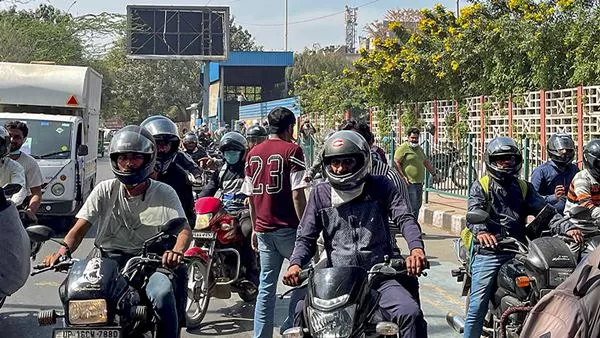SEO Meta Description:
India’s new guidelines now allow private motorcycles as bike taxis, creating big changes for gig workers, pollution control, and urban mobility. Here’s what it means for you.
Introduction to the Policy Change
The Indian central government has just taken a bold and controversial step: It now allows private motorcycles as bike taxis via platforms like Rapido, Ola, and Uber. Under the revised Motor Vehicle Aggregator Guidelines 2025, the Ministry of Road Transport and Highways (MoRTH) has empowered state governments to permit this mode of transport. This decision could reshape how millions of Indians commute, work, and navigate congested cities.

What Are the Motor Vehicle Aggregator Guidelines 2025?
The new guidelines provide a national-level framework for ride-hailing services. For the first time, private non-transport two-wheelers are explicitly allowed to carry passengers, provided they meet specific conditions. The main highlights include:
- Legalising bike taxi services on aggregator apps.
- Empowering states to set their own terms.
- Establishing safety protocols and insurance mandates.
- Reducing reliance on public transport during peak hours.
Why This Move Matters for India
India is notorious for urban congestion, air pollution, and overburdened public transport systems. This policy aims to tackle those issues by:
- Encouraging last-mile connectivity.
- Enabling eco-friendlier transport options.
- Creating flexible job opportunities in the gig economy.
Central Government’s Stance on Bike Taxi Operations
Private Motorcycles Now Allowed as Taxis
One of the boldest elements of the policy is the approval of private motorcycles as bike taxis. Previously, only vehicles registered as “transport” could be used. Now, even privately registered motorcycles can be used—opening the door to millions of vehicle owners to participate in the sharing economy.
Safety & Insurance Mandates for Riders
To ensure public safety, the guidelines also include:
- Mandatory police background checks.
- Medical fitness and driver training programs.
- Substantial health and term insurance for all bike taxi drivers.
Benefits for Hyperlocal Deliveries
These private motorcycles are not just limited to passenger transport—they can also be used for hyperlocal deliveries, a crucial lifeline for businesses in e-commerce and food delivery.
Power Shift: Role of State Governments
Discretion to Implement or Reject
Even though the Centre has greenlit the policy, each state has the final say. They can either implement the guidelines, modify them, or outright reject them. States can also levy nominal authorisation fees—daily, weekly, or fortnightly.
Example: Karnataka’s Previous Ban
Karnataka had recently banned bike taxis following a High Court order. Authorities cited the absence of clear legal backing for private motorcycles offering paid rides.
Could Karnataka Reverse the Ban Now?
With the Centre’s new push, Karnataka and similar states now have legal justification to legalise bike taxi services, pending the drafting of their own rules and formal notifications.
Economic and Social Impact of Allowing Bike Taxis
Opportunities for Gig Workers
This move opens massive opportunities for gig workers, especially in Tier-2 and Tier-3 cities. A young person with a smartphone and a scooter can now legally earn an income by ferrying passengers or goods.
Impact on Traditional Auto Rickshaws
However, not all stakeholders are pleased. Traditional auto and cab drivers fear market cannibalisation and fare competition. Balancing regulation with innovation will be key.
Opposition & Concerns from Stakeholders
Common Criticisms of Bike Taxis
Critics point to:
- Safety risks without seatbelts or protective barriers.
- Difficulty in regulating personal vehicle use.
- Potential insurance fraud or policy misuse.
Addressing Public Safety and Urban Chaos
MoRTH has recommended strict checks and penalties to avoid misuse, including proper documentation and mandatory aggregator registration for drivers.
Future of Urban Mobility in India
Tech Integration and App-Based Growth
India is witnessing an app-first revolution in transportation. Ride-sharing, especially bike-based, is cheaper and quicker for short distances. This move accelerates that shift.
Environmental Sustainability Factors
By allowing shared use of private vehicles, this policy may:
- Reduce vehicular congestion.
- Lower carbon emissions.
- Improve fuel efficiency across cities.
FAQs About Private Motorcycles as Bike Taxis
1. Can I use my own bike for Rapido or Uber rides now?
Yes, if your state government authorises it under the new MoRTH guidelines.
2. Do I need commercial registration?
No, private motorcycles can be used—but compliance with safety, insurance, and aggregator registration is necessary.
3. What if my state hasn’t approved the policy yet?
You cannot operate legally until your state notifies its rules.
4. Are bike taxi drivers covered by insurance?
Yes, aggregators must provide both health and term insurance for all drivers.
5. Will there be a fee to operate as a bike taxi?
States may charge a daily, weekly, or fortnightly fee for operating.
6. What about safety concerns?
Police verification, medical exams, and driver training are mandatory to ensure passenger safety.
Conclusion: A Progressive Step or Policy Gamble?
The central government’s approval of private motorcycles as bike taxis is a monumental change in how India views urban transport. It brings innovation, flexibility, and economic opportunity—but also demands responsible implementation. States must now rise to the challenge and regulate this space smartly, ensuring safety and fairness for all stakeholders.
🔗 Explore the official MoRTH Guidelines 2025 here: Ministry of Road Transport









